Night Moves
This article was originally written by William Craske and published in ‘Prime Mover, July, 2019’ more information on the Prime Mover Magazine can be found here
The Australian freight industry awards have been an institution for three decades in Melbourne. This year marks the 3oth anniversary of a long standing tradition in which the hard working men and women of the road transport sector celebrate their achievements.
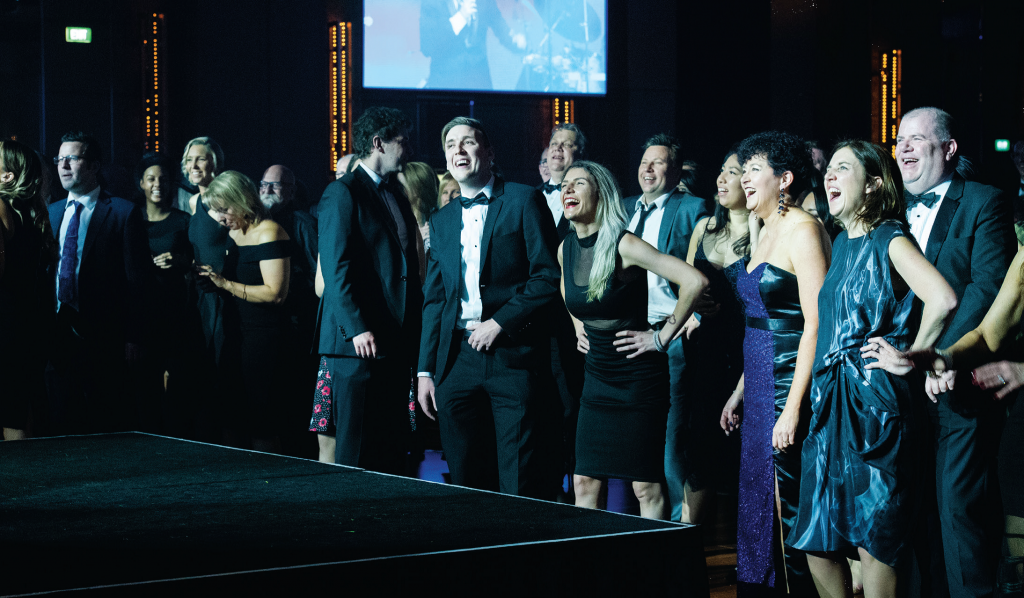
This year marks the 30th anniversary of the awards
Picture a golf cart headed towards a stage in an enormous room, as it winds its way through a crowd of 3000 people, most of whom are seated, dressed in evening wear. While in transit to collect an award, the mic’d up passenger is being interviewed on a live broadcast seen on one of several giant television screens mounted, by one of the 76 riggers who has been employed to create the sprawling production, on the walls of the Melbourne Convention & Exhibition Centre. The year is 1999.
In just ten short years the Australian Freight Industry Awards Gala Presentation has escalated to the point of having three dedicated kitchens each catered to serve 1000 people. It wasn’t originally conceived to be this big according to long time organiser and former Victorian Transport Association CEO, Phil Lovel, who hosted and helped co-ordinate the event during its first 28 years.
“As far as we were concerned it was an event like no other and, at the time, we could not have foreseen it getting so big,” recalls Phil. “Not given its humble origins.”
It began in 1989 as a party to culminate an annual conference for what was then called the Australian Road Transport Federation (ARTF). Bob Hawke was in his fourth term as Prime Minister.
Phil, on the suggestion of then Marketing Manager Alan Pearce, moved the conference to Singapore to get around a long standing industrial dispute between domestic pilots and airlines that had crippled all interstate travel by air. So along with 470 couples, he headed overseas to get around it. At the completion of the conference a celebratory dinner with presentations concluded on the weekend. Rolf Harris hosted.
Upon return Phil got to talking with Allan Jones, a senior executive at TNT in the UK, who made mention of an annual awards ceremony in England he attended that attracted nearly 1000 people. That’s how, according to Phil, the AFIAs got officially started.
The first event, under the new banner, was held in September of 1990 with 350 guests in attendance.
“No one really saw the transport industry in any great light at that time,” Phil says. “We were just truckies in the eyes of many.”
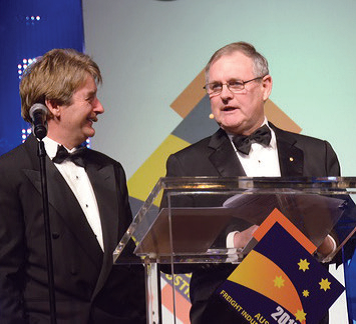
In 1991 it was decided that it would be a black tie event. The crowd grew in size to around 500 people. People came from interstate on the strength of its growing reputation. Guests, in turn, started bringing their customers to flaunt the new, sophisticated image of the transport industry. With every subsequent year, until the apogee of the golf carts and a football crowd, the event had precipitously grown in size and popularity.
“Having all the truckies, the drivers, the sales reps and couriers in black tie helped change the perception of the rough, soiled blue singlet and shorts image that had long been associated with the profession,” Phil says. “It was a real commemoration of the work and effort that went into the road transport industry and many people wanted to be part of it.”
Glen Cameron, Managing Director of Cameron’s, one of Melbourne’s largest freight carriers, was among them. The inaugural winner of the Fleet Operator of the Year Award in 1990, Glen says his memory of attending his first awards evening is still vivid.
“I remember distinctly checking into the hotel that day and bumping into Phil Lovel and Gavin Murphy and other people who were setting up the hall and thinking how wonderful it was going to be part of the industry getting together,” he says. “Then winning it that night took me by complete surprise.”
Having worked out of a phone box when he first started out, Glen over the next 14 years built the Transport Group now synonymous with his name to a reasonably sized operation in 1990 but it was not yet comparable to the likes of TNT and IPEC, who were at the time, the dominant forces in road transport in Victoria.
“We were in a pretty difficult position in those years with high interest rates, coming off a bit of an economic depression and different things happening so it was a tough period,” he says. “The Australian Freight Industry Awards were a great encouragement to a lot of people.”
Since then Glen has been nominated for Best Fleet of the Year a further four times and won it on three occasions. In 1993 he was recognised as the Personality of the Year.
The essence of the awards, according to VTA CEO Peter Anderson, who has been charged with running the event over the past five years, is to help provide recognition for those people that have gone above and beyond their normal duties and responsibilities.
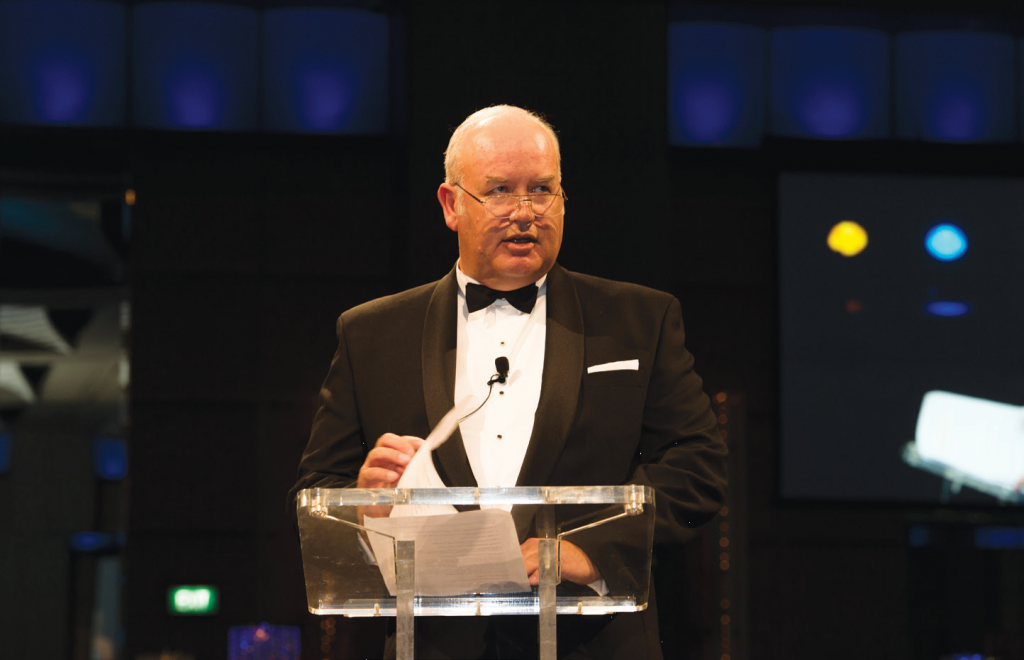
“It’s really recognising the fact that some people stand out from others and along the way the good that they’re doing is acknowledged,” he says. “Why does a customer buy from one service and not another? The industry is about creating a differential and the awards give us an opportunity to mark those differentials that really stand out against competitors. The industry is full of good effort and people who are trying to go above and beyond.”
From its inception, it was Alan Pearce who developed the concept of the event with Freight Congress in 1989 – and expanded it. His long term vision helped to elevate the industry’s profile with the general public.
“We made the move to black tie to make a statement,” says Pearce. “It was about showing how the industry was a class act. That meant demonstrating it was about safety and responsible road management and we built the awards around those criteria.”
From that launching pad he pushed the event aggressively within the trade magazines, the Herald-Sun and the Weekly Times. Word soon spread. According to Alan it was the catalyst to lift morale and standards within the road transport community even though the concept of OH&S was only in its infancy.
“Everything hinges on timing and it was so well accepted that the event rapidly grew in the first few years to the point we were having trouble trying to accommodate it,” he recalls. “The legacy from the awards and accolades that flowed from it was that everyone who attended had a bloody good time.”
In the early years the awards found a home at the Ballarine Banquet Hall which was part of the old World Trade Centre and home to the first incarnation of Crown Casino. Many of the popular Australian acts from the ‘50s, ‘60s and ‘70s performed live at the event thanks to the involvement of one of Australia’s top show-biz promoters, Wally Bishop. These included the Seekers, Normie Rowe, Glen Shorrock, Billy Thorpe, Daryl Braithwaite and others. The ages of those in the audience was broad, spanning from 25 to 75, making it an inclusive gathering which became the yearly event to attend in the industry from both a social and business perspective.
“We were trying to get people together who spoke the same language and to create an atmosphere they wanted to be part of while delivering a message that safest practice was best for their business and the industry,” says Alan. “And it worked. They were receptive. If it was about just getting together to party then it probably wouldn’t have happened.”
Bumping into the old Convention Centre with B-doubles required some finessing. Alan got together with some of the technical brains of the Victorian industry to get around a conundrum. What weight per square centimetre would an unladen B-double with a 12.5 tonne Kenworth attached to it do to the underground carpark?
Surprisingly, when factoring in the number of tyres, sharing the load, it wasn’t that much. “It’s less weight than what a stiletto shoe holds in the same area,” says Alan. “We had to run the trucks in unladen after that.”
In 1999, for its tenth anniversary and finale in partnership with Freight Congress, Phil and Alan’s team needed to create a ballroom out of an “empty shed”, per Alan, to seat over 3000 people. The VTA, by then, had since moved to the newly built Melbourne Convention & Exhibition Centre, where among an array of monumental challenges, they needed to dress, light and stage the room. It took seven B-doubles of equipment and a full week to bump in carpet, drapes, lighting and staging according to Alan. The biggest problem, in a room that size, he says was the feedback.
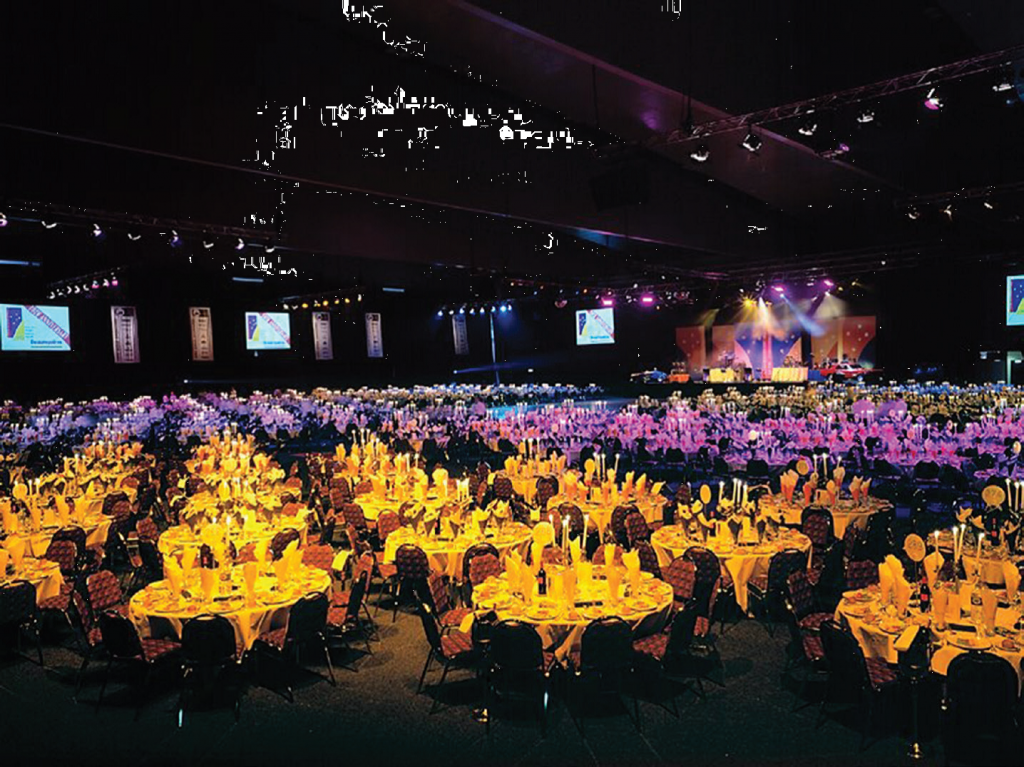
The room before the 1999 event
“If you stood in the centre of the undressed 4000 sqm area and clapped your hands you would get seven echoes before it stopped,” he recalls. “In the perfect sound environment you’ve only got two. We had to curtail the reverb effect if we had any chance of getting the music across through the massive sound system so the people in the back didn’t experience that relay effect.”
The next major obstacle was how would they feed everyone remembers Phil.
“The meal had to be on time and A-grade quality,” he says. That required, simply, establishing three separate kitchens and bringing in addition to the food, the staff to cook and serve it and the cutlery. All totalled 18,000 glasses were ordered.
“There was,” says Alan, with a touch of pride, “not one complaint about the food.”
Then there were those golf carts.
“I’d announce the winner on stage and the golf cart which had a camera mounted to it would go down and pick them up and on the way they would get interviewed, they’d come up on stage be presented with their award and disappear again,” Phil says.
He even paid two doctors to monitor the audience from above in case anyone needed medical assistance.
Denise Drysdale and Ernie Sigley were the co-hosts that night. Dragging Ernie away from back stage where he was glued to a TV broadcast of the qualifying final, with his beloved team the Western Bulldogs, proved yet another challenge.
The event was eventually moved from the Melbourne Convention & Exhibition Centre to its current home in the grand Palladium Room at Crown.
“There was no other venue in Melbourne that could seat the numbers we needed in a pillar-free environment,” says Alan.
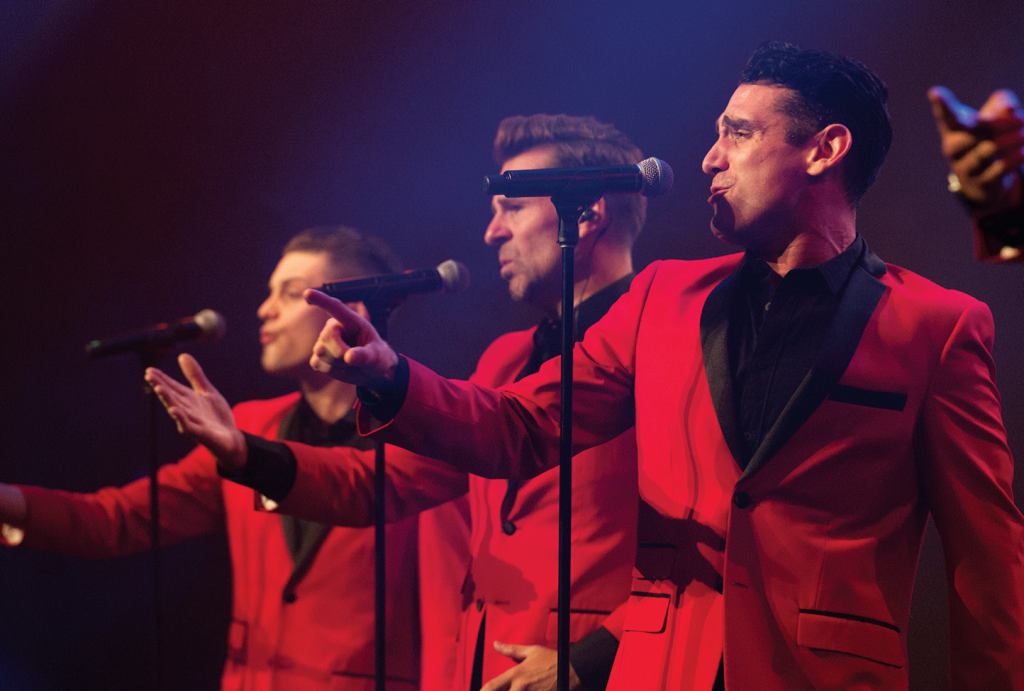
More recently the VTA has built the AFIAs around a theme. Last year it was The Greatest Show on Earth and for the 30th anniversary the event will celebrate the music of Queen following the popular biopic Bohemian Rhapsody. A rotating stage, prominently situated in the middle of the room which was introduced in 2017, will return. Last year it accommodated 80 professional dancers.
The event, according to Glen Cameron, is a great opportunity to catch up with compatriots in the industry and have some fun. He says the VTA don’t do anything by halves.
“The VTA has always been a great organisation to work with and represent the industry,” he says. “They’ve always given me individually and as a business great advice all through the last 44 years. I trust them and think they’re a very competent organisation. It’s been a great initiative. They’ve done a great thing.”
Staging the event is like a military operation according to Anderson. The team is well practiced. He recalls back in the ‘90s sitting in a giant adjoining room that the organisers booked to augment the main gala which had been sold out before tickets had even gone on sale, causing a spill-over. It was the first Freight Industry awards Anderson attended.
“I’m not sure we’ll ever get back to the heady days of three and half thousand people again. That was just madness,” he recalls fondly. “It still remains a huge event to have been kept going for 30 years and we’ve kept it going because of what it means to the industry. As the CEO it gives me the opportunity to say thank you to all of those people who have helped us along the way.”
This year’s awards scheduled for Saturday 7 September at Crown Palladium will recognize the Personality of the Year, Young Achiever Award, Sustainable Environment Award, Application of Technology Award, Best Practice Safety Award, and Investment in People Award.

